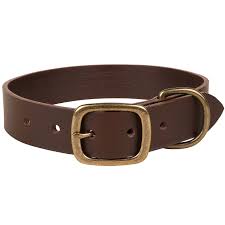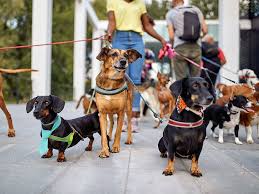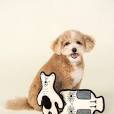The Essential Guide to Dog Collars
Dog collars are not just a fashion accessory; they serve important functions in keeping your furry friend safe and secure. With a wide variety of collars available on the market, it’s essential to choose the right one for your dog’s specific needs.
Types of Dog Collars
There are several types of dog collars to choose from:
- Buckle Collars: These traditional collars have a buckle closure and are adjustable for a secure fit.
- Martingale Collars: Also known as limited-slip collars, these are designed to prevent dogs from slipping out of their collars.
- Harnesses: While not technically collars, harnesses are an alternative that can be gentler on a dog’s neck, especially for breeds prone to tracheal issues.
- Choke Chains: These training collars should be used with caution and under the guidance of a professional trainer to prevent injury.
- Prong Collars: Similar to choke chains, prong collars should only be used under the guidance of a professional trainer.
Choosing the Right Collar
When selecting a collar for your dog, consider the following factors:
- Size and Breed: Choose a collar that fits comfortably and is appropriate for your dog’s size and breed.
- Metal vs. Nylon: Metal collars may be more durable but can be harsh on some dogs’ skin, while nylon collars are lightweight and come in various designs.
- Purpose: Consider the intended use of the collar – whether for everyday walks, training, or identification purposes.
- Safety Features: Look for reflective or LED collars for added visibility during nighttime walks.
Caring for Your Dog’s Collar
To ensure your dog’s collar remains in good condition, remember to:
- Clean it regularly with mild soap and water.
- Check for wear and tear, such as fraying or rusting hardware.
- Adjust the fit as needed to prevent discomfort or escape.
7 Essential Tips for Choosing and Maintaining Your Pet’s Collar
- Choose the right size collar for your pet to ensure a comfortable fit.
- Regularly check the collar for any signs of wear and tear, and replace if necessary.
- Ensure that the collar is not too tight or too loose around your pet’s neck.
- Consider using a breakaway collar for cats to prevent accidents or injuries.
- Personalize your pet’s collar with identification tags in case they get lost.
- Clean the collar regularly to prevent dirt and bacteria buildup.
- Train your pet to associate the collar with positive experiences to make wearing it more enjoyable.
Choose the right size collar for your pet to ensure a comfortable fit.
Choosing the right size collar for your pet is crucial to ensure a comfortable fit. A collar that is too tight can be restrictive and uncomfortable for your furry friend, while a collar that is too loose may pose a safety risk if your pet can slip out of it easily. By selecting the appropriate size collar, you can ensure that your pet stays secure and comfortable during walks and everyday activities.
Regularly check the collar for any signs of wear and tear, and replace if necessary.
It is crucial to regularly inspect your dog’s collar for any indications of wear and tear, such as fraying or damaged buckles. If you notice any signs of deterioration, it is important to replace the collar promptly to ensure your dog’s safety and comfort. By maintaining a close eye on the condition of the collar, you can prevent potential accidents or injuries and ensure that your furry companion remains secure during walks and activities.
Ensure that the collar is not too tight or too loose around your pet’s neck.
It is crucial to ensure that the collar is neither too tight nor too loose around your pet’s neck. A collar that is too tight can cause discomfort, restrict breathing, and even lead to injury, while a collar that is too loose may slip off or allow your pet to escape. Properly fitting the collar ensures your pet’s safety and comfort during walks and everyday activities. Regularly check the fit of the collar to make adjustments as needed for your pet’s well-being.
Consider using a breakaway collar for cats to prevent accidents or injuries.
When choosing a collar for your cat, consider using a breakaway collar to prevent accidents or injuries. Breakaway collars are designed with a safety feature that allows the collar to release if it gets caught on something, reducing the risk of choking or injury. This type of collar is especially important for outdoor cats who may encounter various hazards. By opting for a breakaway collar, you can provide your feline friend with added protection and peace of mind.
Personalize your pet’s collar with identification tags in case they get lost.
Personalizing your pet’s collar with identification tags is a crucial step in ensuring their safety and well-being. In the unfortunate event that your furry friend gets lost, these tags provide vital information for a quick reunion. Include your pet’s name, your contact number, and any other relevant details to help others identify and return your beloved companion to you promptly. By adding identification tags to their collar, you are taking a proactive measure to increase the chances of a happy ending in case of an unexpected separation.
Clean the collar regularly to prevent dirt and bacteria buildup.
Regularly cleaning your dog’s collar is essential to prevent the buildup of dirt and bacteria. A dirty collar not only affects your dog’s hygiene but can also lead to skin irritation and infections. By maintaining a clean collar, you ensure that your furry friend stays comfortable and healthy during their daily activities. Remember to use mild soap and water for cleaning and inspect the collar for any signs of wear and tear to keep it in good condition.
Train your pet to associate the collar with positive experiences to make wearing it more enjoyable.
Training your pet to associate the collar with positive experiences can make wearing it a more enjoyable and stress-free experience for both you and your furry friend. By pairing the act of putting on the collar with treats, praise, or playtime, your pet will start to see the collar as a signal of something good to come. This positive reinforcement can help reduce any anxiety or resistance towards wearing a collar and can strengthen the bond between you and your pet.




